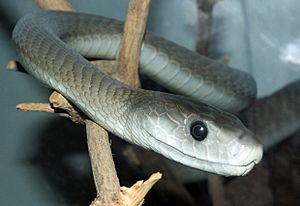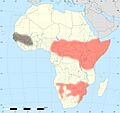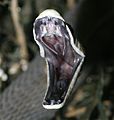Black mamba facts for kids
Quick facts for kids Black mamba |
|
|---|---|
 |
|
| Conservation status | |
| Scientific classification | |
 |
|
| Distribution range of black mamba in red (grey areas are inconclusive) | |
| Synonyms | |
|
List
Dendroaspis polylepis polylepis
(Günther, 1864) Dendraspis polylepis (Günther, 1864) Dendraspis angusticeps (Boulenger, 1896) Dendraspis antinorii (Peters, 1873) Dendroaspis polylepis antinorii (Peters, 1873) |
The black mamba (Dendroaspis polylepis) is a very venomous snake. It is the second-longest venomous snake in the world. Only the king cobra is longer. Its venom is often deadly if a special medicine called antivenom is not given quickly. Even though it has a scary reputation, the black mamba usually only bites if it feels threatened or trapped.
This snake lives in parts of sub-Saharan Africa. It is listed as "least concern" by the International Union for Conservation of Nature (IUCN). This means it is not currently in danger of disappearing.
Contents
What Does a Black Mamba Look Like?
Despite its name, the black mamba isn't actually black. Baby mambas are often brownish-gray. As they get older, they turn a grayish-brown or olive-brown color. They get their name from the dark, almost black color inside their mouth. They show this dark mouth when they feel threatened.
These snakes are very long and thin. Adult black mambas can grow to be 6.5 to 14 feet (2 to 4.3 meters) long. They move very gracefully. Their smooth scales can shine in the sunlight. They have large, round eyes that can be grayish-brown or even black.
A black mamba usually weighs about 1.6 kg (3.5 lb).
Where Do Black Mambas Live?

Black mambas are found in sub-Saharan Africa. They like warm, dry places. These include savannas, grasslands, and rocky hillsides. Sometimes, they live in woodlands. They are excellent climbers and are often seen in trees. However, they also spend a lot of time on the ground.
How Do Black Mambas Behave?
Even though they are famous for being dangerous, black mambas are actually quite shy. They prefer to stay away from humans and other dangers. They are incredibly fast. They can move at speeds up to 12 miles (19 kilometers) per hour!
When they feel threatened, they can lift their upper body high off the ground. This shows off their impressive size and dark mouth. This is their way of telling possible attackers to stay away. If someone moves suddenly during this warning, the snake might strike quickly.
How Do Black Mambas Reproduce and Live?
Black mambas lay eggs to have babies. A female mamba usually lays 6 to 25 eggs. She often hides them in a safe spot, like a crack in a rock or a termite mound. The eggs hatch after about 2 to 3 months.
The baby mambas are born with their deadly venom already working. The mother mamba does not take care of her young. The baby mambas are completely on their own from the moment they hatch. Black mambas have been known to live for up to 11 years. They might even live longer in the wild.
What Do Black Mambas Eat?
Black mambas are carnivores. This means they eat meat. Their diet mostly includes other animals. They eat smaller snakes, lizards, rodents (like mice and rats), and even birds.
They are very fast and quick hunters. They use their speed to surprise their prey. They strike quickly and accurately. Then, they use their powerful venom to make their meal unable to move.
Who Are the Black Mamba's Predators?
Adult black mambas have few natural enemies. Some birds of prey hunt them. These include Brown snake eagles, tawny eagles, and martial eagles. Other predators are southern ground hornbills, marsh owls, and hooded vultures. Young snakes have been eaten by the Cape file snake. Black mambas have also been found inside Nile crocodiles.
The Black Mamba's Venom
The black mamba is one of the most feared snakes in Africa. This is because of its size, how it defends itself, and how strong its venom is. A bite from a black mamba can make a person collapse in less than an hour. If the right antivenom treatment is not given, the person will have trouble breathing. This can lead to serious health problems and death. This usually happens within 7 to 15 hours after the bite.
Unlike many other venomous snakes, black mamba venom does not usually cause swelling or tissue damage where it bites. The first sign might just be a tingling feeling. The snake often bites more than once and lets go. So, there can be several bite marks. A single bite can deliver about 100–120 mg of venom. The most ever recorded was 400 mg. Before antivenom was widely available, black mamba bites were almost always fatal.
Treating a Black Mamba Bite
If someone is bitten by a snake that might be venomous, the first thing to do is apply a pressure bandage to the bite area. The person should move as little as possible. It is very important to get them to a hospital or clinic as fast as possible.
Because black mamba venom affects the nervous system, a special bandage called an arterial tourniquet might help. A tetanus shot is sometimes given. But the most important treatment is the right antivenom. A special antivenom made in South Africa is used to treat black mamba bites. New antivenoms are also being developed.
Cool Facts About Black Mambas
- They can move as fast as 12 mph (19 km/h).
- Adult black mambas can grow up to 14 feet (4.3 meters) long.
- Their venom is a very strong neurotoxin, which affects the nervous system.
- Black mambas have excellent eyesight.
- Their bodies can digest a meal completely in about eight to ten hours.
- A black mamba can strike upwards as much as 40% of its body length. This means they can bite people on their upper body.
Images for kids
See also
 In Spanish: Mamba negra para niños
In Spanish: Mamba negra para niños











